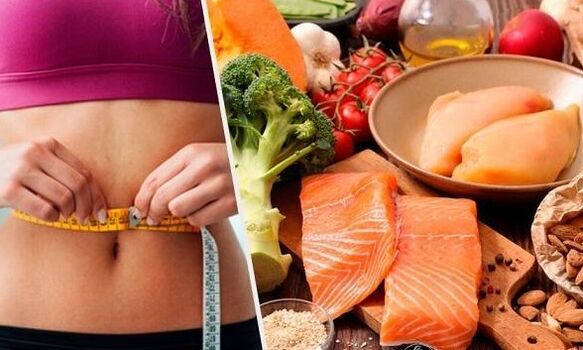The ketogenic diet (keto) is a low carbula diet that helps to burn fat. It has many advantages for weight loss and better health, but also some side effects.

- The advantages of the Keto diet
- Which is forbidden to the Keto diet
- How to find out what are you in ketoss?
- Side effects of a diet and how to avoid them
The ketogenic diet is similar to other rigid diets with low carbohydrate content such as Atkins or Lchf diet. These diets often end with ketogenic more or less by chance. The main difference between the rigorous Lchf diet and keto is that the protein is limited in the latter.
With ketosis, the body produces small fuel molecules called "ketoni". This is alternative body fuel.
Keton are produced if very few carbohydrates are eaten (which are quickly divided into blood sugar) and a moderate amount of proteins (excess protein can also be converted into blood sugar).
How to lose weight in children's food?
The ketoni are formed in the liver of fats. Then they are used as fuel throughout the body, including the brain. The brain is an organ that consumes a lot of energy every day and cannot work directly on the fat. It can only work on glucose. . . or on the ketones.
With a ketogenic diet, the whole body passes from the supply of fuel with carbohydrates and works almost completely on fat. The insulin level becomes very low and the combustion of fat increases sharply. The body is easy to access your fatty reserves to burn them.
The advantages of the Keto diet
The advantages of a ketogenic diet are similar to any low carbohydrate diet. However, the effect can be even higher, since the protein is limited. This diet increases the level of ketone and reduces the insulin level.

- The combustion of fats on the keto diet increases significantly, because insulin falls. This creates the ideal conditions in which weight loss can occur without hunger.
- About 20 scientific studies show that, compared to other diets, the low carbohydrate and keto diet lead to a more effective weight loss.
- Ketosis leads to a sustainable fuel intake (ketoni) in the brain. And with a ketogenic diet, you will avoid great fluctuations in blood sugar. This often leads to an increase in attention and the increase in concentration.
- Many people specifically use a keto diet to increase mental performance. After a few days (up to a week), the adaptation kept, during which a person can find some difficulties with concentration, headache, irritability: the body and the brain will change and will be able to work easily on the ketones.
- In a state of ketosis, many people experience more energy.
- The ketogenic diet can also significantly increase your physical resistance, giving you constant access to energy from your fatty reserves.
- The supply of the body with carbohydrates (glycogen) is sufficient only for a couple of hours of intensive training or not. When, since fatty reserves will give enough energy for long and intense classes.
Which is forbidden to the Keto diet
The most important thing is that to obtain ketosis it is necessary to avoid the use of carbohydrates, ideally reduce consumption of less than 20 grams. More carbohydrates, more effective.
How to find out what are you in ketoss?
Ketosis can be measured by testing urine, blood or breathing. But there are clear signs. Symptoms of ketosis: dry dry, thirst, frequent urination.
Dry and iced thirst Faucia. If you drink enough and you have quite electrolytes, you can feel your mouth dry. Try drinking a cup of broth or two a day, as well as drinking all the water you need.
The increase in urination is another symptom of ketosis.

D-drying that straight to the ketone bodies, the smell of the eriton appears from the mouth, the smell can also be "fruit" or resemble the smell of the paint fluid. This smell is sometimes warned by sweat, all this will pass for a short period and after a keto-Keto adaptation will pass.
Other signs, less specific, but more positive include:
Hunger reduction: many people suffer a significant reduction in hunger. This can be caused by the greater body ability to be fed by its fatty reserves. Many people feel very well, they only eat one or twice a day, you can make a periodic fast. This saves time and money and also accelerates weight loss.
An increase in energy - After a few days, a feeling of fatigue will pass and you will feel an increase in energy and performance.
How to get sustainable ketosis
- Limit carbohydrates up to 20 grams per day.
- Limitation of squirrels at a moderate level. It is necessary to remain at a level or less than 1 gram of proteins per day for kg of body weight. It is about 70 grams of proteins per day if youigh 70 kilograms.
- There is a sufficient quantity of fats to feel full.
- Avoid snacks when it is not hungry. Snacks unnecessary slow down weight loss and reduce ketosis.
If necessary, it is necessary to add a periodic hunger, for example 16: 8-16 hours of hunger and 8 hours for food consumption. This is very effective for increasing ketones.
Side effects of a diet and how to avoid them

In the initial phase of the transition to the keto mode, side effects can occur - this is called Keto -Gripp. Symptoms such as fatigue, nausea, headache, cramps, etc. What must be done to prevent or alleviate these symptoms:
- Drink water with salt and lemon: you also have to drink a cup of broth every day.
- Gradually reduce carbohydrate consumption - a strong reduction leads to stronger symptoms
In the initial phase of a ketogenic diet, lose water and, therefore, electrolytes. This happens because carbohydrates delay water and salt in the body, so when you stop eating carbohydrates, your body loses this water.
When carbohydrates were suddenly removed from the diet, the brain needs time before it learns to use ketone bodies for energy instead of sugar. This means that if you abruptly reduce carbohydrates, it is possible to obtain symptoms, such as fatigue, nausea and headache. Reduce the consumption of carbohydrates for a week or more, the body will get used to burn fat and ketones instead of glucose and, the transition will take place easier and without symptoms.































